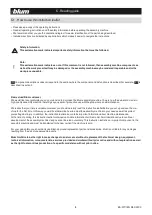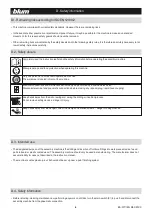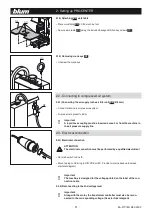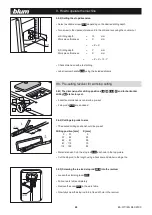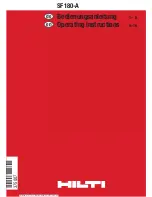
7
BA-077/1EN M6X.20XX
• Only use sharp, clean drill bits.
• Particular care must be taken when working on sections that jut out over the work top. Attach a larger work table or use extensions.
Work pieces should not affect the stability of the assembly machine. Work pieces should be secured against tipping or falling. Use
suitable clamps or support brackets. Operating elements must remain accessible and their accessibility should be not obstructed.
• Secure the work piece during drilling/insertion. Use the assembly machine clamps or if these are not sufficient for the particular job,
use suitable clamping equipment.
• Wear appropriate work clothing.
• You should always check that all safety devices and machine parts are functioning properly before use. Replace damaged parts
with original Blum parts.
• Make sure that no other tools or objects are on the work table aside from your work piece before turning on the assembly machine.
• Always turn the main switch (E1) to POS. 0 after finishing work
• CAUTION: For your own safety, use only those accessories which are recommended or indicated in the manual or Blum sales
literature.
• Do not make any alterations or modifications to the assembly machine.
• If there are any questions and/or problems, please contact the BLUM Customer Service Department.
• All national regulations regarding labour law, industrial safety as well as all disposal guidelines must be followed.
D - Safety information
D.5 - Noise emission
Noise emission levels as per EN ISO 11202 (11204) are:
Work place noise level is (work cycle): 80.4 dB(A) (measured at a height of 1.5 m and at 1 m forward of the worktable edge. The ambi-
ent correction factor K3A is 4 dB and is calculated according to EN ISO 11204 Appendix A. The difference between the extraneous
noise level and the sound intensity level at each measuring point is > 6dB)
The specified values are emission values, which means that they are not necessarily safe workplace values at the same time. Al-
though there is a correlation between emission and emission values, the necessity of additional precautions cannot be deduced with
certainty. Factors liable to influence current emission levels in the workplace include the length of exposure, the characteristics of the
workroom, and other noise sources. Also, admissible workplace levels may vary from country to country. The information provided
here is designed to enable users to assess the hazards and risks involved more accurately.
D.6 - Dust emission
If connected properly to a dust extraction system, dust emissions fall clearly below the technical standard value. The assembly ma-
chine is equipped with a connecting piece for hoses with an inside diameter of 100 mm. This provides negative pressure of 2000 Pa
for the maximum required average air velocity of 20 m/sec. If there is no extraction system connector with a diameter of 100 mm, the
supplied adapter can be used. For connection, make sure that a minimum air velocity of 20 m/sec is provided at the cross-section of
the 100 mm hose.
• The assembly machine must be connected to a dust extraction system. (The extraction system connection must be flexible and
flame resistant)
• Regularly remove remaining dust and chips using a vacuum cleaner.





